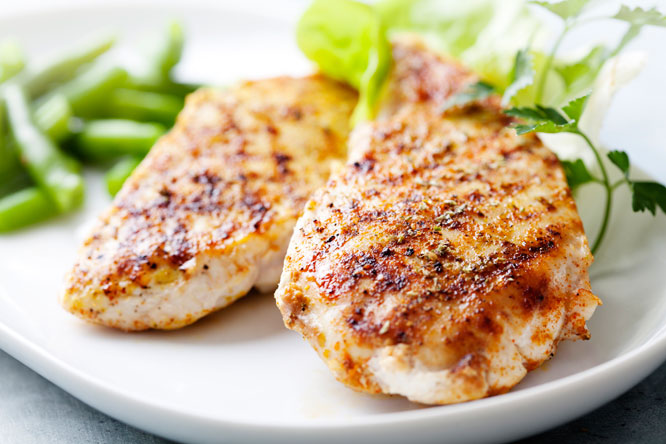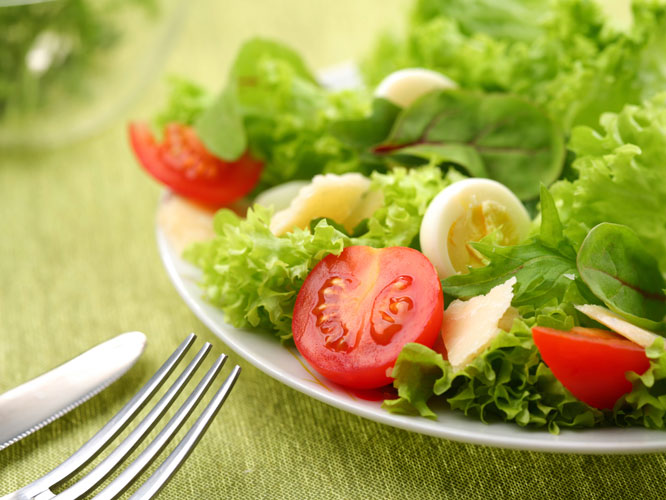28-Days-to-Lean Meal Plan
With the right plan and the right discipline, you can get seriously shredded in just 28 days.
Read article
Everyone knows crushing weights won't get you anywhere if you don't have the right diet to match. Even if you think you're eating all the right things, taking all the right supplements and getting all the right nutrients at the right time, there might be some adjustments you can make to reach your goals faster. That's where we come in.
This week, Eric Falstrault, founder of BODHI Fit in Montreal, Canada, takes a look at a meal plan from Muscle & Fitness reader Toni Lesatz. Want help with your diet? Submit it to Diet911@muscleandfitness.com and one of our nutrition experts will take a look.
"I'm trying to lose 15 pounds and gain muscle with strength training at the same time."
Although I’m missing some basic information, what you sent gave me a good idea that you’re making one of the most common mistakes by women trying to gain lean muscle. Contrary to popular belief, it is possible to gain lean mass and lose fat at the same time. Women aren’t that different from men, but there are some small differences when it comes to training and dieting down to the perfect body fat percentage. For example, an ideal body fat range for females is 15 percent and for males 10 percent when tested with a 12-fold-site caliper test.
Why is body fat so important? Let’s say you lose 10 pounds. You could lose 10 pounds of fat or muscle mass, but on the scale, it still comes out to 10 pounds, but with very different health consequences. Losing 10 pounds of lean mass means inflammation and higher cortisol, lowered metabolism rate and, most probably, fat gain. This is only the start of a cascade of unhealthy consequences. Although some people will say we still need fat to be healthy, if you stay within the range of 10 to 15 percent, you won’t have any problem gaining lean mass and maintaining a healthy lifestyle. In these ranges, the body functions optimally, I see it and prove it all the time with client’s blood work.
How Did Our Expert Fix This Diet? >>

The two main things I would focus on looking at your diet would be to increase quality lean protein and nutrients and the calorie deficit. Except for garden salads, greens or colorful veggies are practically nonexistent in your diet. I am not a big believer of ‘’calories in should equal calories out’’ but I am always looking for balance. Different bodies mean different needs so there is no one trick that fits all situations. The rule of thumb if you want to gain lean mass and lose fat is to have mostly the same amount of calories that goes in compared to the ones you burn. If you want to lose fat, you could be under by 300 calories or so and if you want to gain lean mass, I would try to eat the same amount and maybe more calories than your basal metabolic rate.
Let’s look at how the basal metabolic rate works. Let’s say your basal metabolic rate is 2000 calories. If you train 4 to 5 days a week, you have to multiply that number by 1.7 to compensate for caloric expenditure. So now you burn about 3400 calories a day. In your current case, you don’t even reach your basal metabolic rate, so there’s no way you can pack on lean muscle mass. This also stops your fat loss results. Your body will be forced into starvation mode since you don’t reach your basic caloric requirements. My advice would be to eat a clean food, nutrient-rich diet such as quality protein, healthy fats and lots of veggies at every meal while cutting down on cardiovascular work.
For both genders, these guidelines are primordial. The body needs balance and our job is to make it easier for it to obtain optimal health. Intense training combined with a low calorie diet will always lead to failure. Keep it simple. You train 2 to 3 times a week? Eat at least 3 meals a day. If you train more than 4 days a week, get at least 4 balanced meals a day keeping in mind the guidelines I have mentioned. The higher the intensity, the higher your caloric intake.
Keep in mind that all calories are not created equal. One thousand calories of chips does not have the same effect than a thousand calories of veggies. See your body as a machine, if it is well oiled and regularly maintained, the motor and parts will run just fine.

Eric Falstrault is a Montreal-based strength coach, Naturopath, Sport Therapist and founder of BODHI Fit. He is certified level 5 PICP (Poliquin International Certification Program) a high level certification program that has proven its grounds on every aspect of the iron game and his specialization is hockey strength and conditioning. Eric has worked with athletes of all levels, from youth sports to professionals in the NHL, NFL and MLS.
Notifications